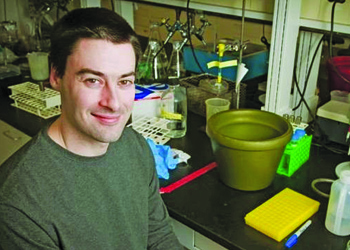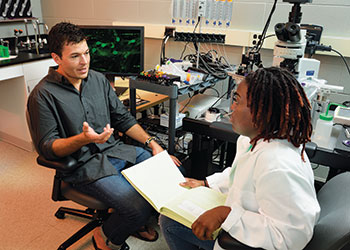Hunt for a Cure - Daring Ideas Advance Science
“Our initial goal was to partner with a university that is equipped with leading edge technology and highly qualified people. We found what we were looking for in our own back yard when we partnered with MSU.
June 4, 2015
It takes novel, sometimes daring ideas to pave the way to great advances in science but sometimes big federal agencies are too cautious to fund projects to test new theories. Hunt for a Cure (HFC), a health advocacy organization based in Grand Rapids, Mich., has established a strong partnership with Michigan State University and its cystic fibrosis (CF) researchers to fund projects that explore just such ideas, the daring ones.
HFC’s goal is to find treatments and a cure for CF to improve the quality of life of those with the disease. It raises awareness and awards significant research grants. HFC’s recent strategic donations to MSU, including $114,000 in 2014 and more than $500,000 overall, have leveraged several major grants from the National Institutes of Health and promise to help MSU generate more research support. Money buys science and MSU science buys life.
Pete Odland, founder and president of HFC, said the partnership with MSU has grown naturally. “Our initial goal was to partner with a university that is equipped with leading edge technology and highly qualified people. We found what we were looking for in our own back yard when we partnered with MSU. Eventually the research that, for example, Dr. Waters is involved in will break the biofilm barrier leading to improved results from antibiotic use. That of course will lead to lengthened life expectancy for CF patients.”
Chris Waters, associate professor of microbiology and molecular genetics, is one of MSU’s lead researchers on CF. He said private support has made his current work possible, “Funding from HFC was critical to the project I am working on as it allowed us to get it off the ground and show we could successfully screen for PaNACEAs,” the acronym for Potent and Novel Anti-biofilm Compounds that Enhance Antibiotics. “Now that we have new research results in hand, we will be even more highly competitive for federal funding from NIH and other sources, which we are actively seeking. But these types of projects will not be funded without the preliminary data we were able to generate with HFC funds.”
The focus of Waters’ CF research is the highly complex study of biofilm. Waters explained, “Biofilm formation by pathogenic bacteria in the lungs of cystic fibrosis patients is the most serious problem that leads to lung failure. Biofilms are multicellular communities of bacteria encased in an extracellular matrix. This form of growth is problematic because bacteria in biofilms are able to resist high levels of antibiotics.”
This means that antibiotics can’t clear the chronic infections that result from this growth. Waters’ team recently found a new way to identify new PaNACEAs that promise to enhance the antibiotic tobramycin that is often given to CF patients. But tobramycin kills only about 50% of biofilms caused by the bacterium Pseudomonas aeruginosa in laboratory conditions. With support from HFC, Waters recently screened 6,080 biologically active molecules and identified 26 novel compounds that virtually eradicate the troublesome biofilms.
Waters said the results have been significant: “We showed that one of our PaNACEAs, already widely used clinically, kills 100% of clinical isolates tested and, when combined with tobramycin, greatly enhances our ability to kill P. aeruginosa biofilms in a CF animal model of infection. These compounds are being examined for their clinical potential to treat CF patients, and we are planning to screen an additional 200,000 molecules for new PaNACEAs.”
New ideas need funding
Even with progress like that made by the Waters team, the battle against CF is just beginning. And good beginnings often involve taking intelligent risks. Dr. Greg Fink, a leading neuroscientist and MSU professor of pharmacology and toxicology, explained: “The importance of private giving is in the quest to obtain federal grant support. HFC has always been extremely helpful, but it is far more important than ever today for two reasons.
“First, the committees that make decisions on federal funding are extremely conservative scientifically. Proposed studies have to be almost a ‘sure thing’ in order to be funded. As a consequence, truly novel and innovative ideas rarely make the cut. Private givers like HFC often see the potential in innovation and cutting-edge science and step up to support exciting new ideas at an early stage of development.
“Second, this particular pathway to discovery is even more important today as the competition for federal biomedical research funds has become extremely tight. This is due in part to general economic issues and in part to some reordering of research priorities within the National Institutes of Health.”
Dr. Fink said HFC’s generous giving is crucial: “The bottom line is that informed private giving by key organizations like Hunt for a Cure is now an essential part of the modern biomedical research enterprise that we all depend on to produce improvements in human health and disease management.”
Pete Odland founded Hunt for a Cure in 2001 in honor of his four-year-old son, Dylan, who has cystic fibrosis. When Pete learned of Dylan’s disease, he knew he had to join the search for a cure. One day while sitting in his tree stand, he came up with the idea for HFC. Ever since, HFC has demonstrated its commitment to raising awareness and research funds to find a cure for CF.
Other current MSU research on CF
A number of crucial projects are ongoing as MSU develops its partnership with HFC and advances its role as a leader in basic health sciences research. Two HFC-supported projects are.
-
Causes of Lung Infections
Dr. Martha Mulks, Department of Microbiology and Molecular Genetics
Dr. Mulks studies serious lung infections. One of the worst is caused by the pathogen Burkholderia cenocepacia. The Mulks research group has identified several genes of this pathogen that play a role in infections in plant and nematode models. The MSU BEACON Center, an NSF Science and Technology Center, will fund a part of the study of how B. cenocepacia evolves within the lungs of CF patients. HFC gifts initiated this work, which will measure loss of genes and gene functions. The team will perform whole genome sequencing on isolates from patients who have been infected for over 25 years.
CF and Diabetes
-
Dr. Dana Spence, Department of Chemistry
Dr. Spence’s group is studying diabetes, a disease closely associated with CF. Rather than working in the most common area of study, bacterial infections, the Spence group is investigating why people with CF have a high occurrence of diabetes. The team is studying the C-peptide molecule, a possible replacement therapy. HFC support has helped persuade government agencies and the pharmaceutical industry to invest in the study of C-peptide efficacy. Last September, the group presented new findings at the European Association for Studies on Diabetes in Vienna, Austria and has been invited to give an update in Stockholm this year. The group has applied to NIH for a four-year, seven-figure award.
For more information about MSU’s Corporate and Foundation Relations, contact University Advancement at univdev@msu.edu or by calling (517) 884-1000 or toll-free (800) 232-4MSU.
Author: Ben Kilpela




